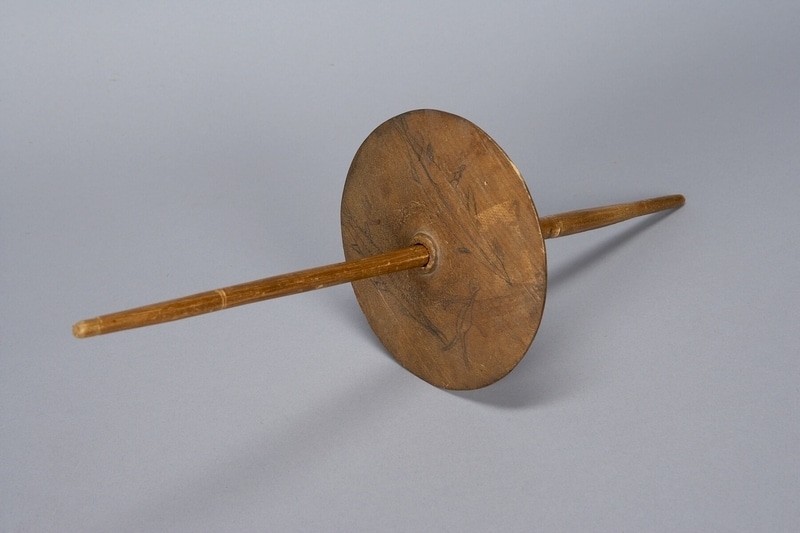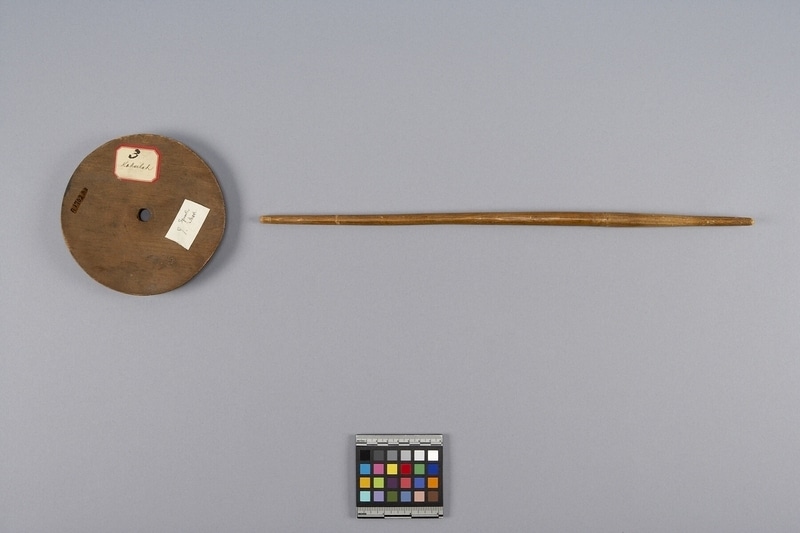Spindle Whorl Item Number: A17028 a-b from the MOA: University of British Columbia


Description
Wooden spindle whorl (parts a-b), consisting of a disc with central hole (a) and long wooden spindle (b). Raised lip around opening on convex ventral surface of whorl; dorsal surface is flat. Decorated on the convex surface with images, in pencil, of two whales and a human figure. One of the whales also has a small human figure depicted on its back. The spindle shaft narrows at each end, and one end is wider than the other.
History Of Use
This spindle was used "for spinning nettle fibre into twine" according to the collector's catalogue and spinning wool or other fibres. Homer Barnett (1955) notes that spindle whorls used by the southern Coast Salish of British Columbia are larger than those used in the north, with a shaft that is twice as long as the whorl. In the north, fibres were spun on smaller whorls that were "twirled between the leg and palm (1955:118)." By contrast, the larger whorls were used to spin fibres that were suspended from overhead. This arrangement created a tension in the roving. Johnson and Bernick (1986) report that traditionally several different techniques were used for turning the spindle, however, contemporary weavers now make use of a spinning machine that is similar in appearance to a treadle sewing machine.
Cultural Context
weaving; spinning; textiles
Item History
- Made in British Columbia, Canada before 1934
- Collected in Koksilah, British Columbia, Canada between 1893 and 1934
- Owned by George H. Raley before November 1948
- Received from H. R. MacMillan (Funding source) and George H. Raley (Seller) during November 1948
What
- Name
- Spindle Whorl
- Identification Number
- A17028 a-b
- Type of Item
- spindle whorl
- Material
- wood and graphite mineral
- Manufacturing Technique
- carved and sketched
- Part A
- height 1.8 cm, diameter 15.6 cm
- Part B
- height 46.8 cm, diameter 1.8 cm
Who
- Culture
- Coast Salish: Quwutsun'
- Previous Owner
- George H. Raley
- Received from
- H. R. MacMillan (Funding source) and George H. Raley (Seller)
Where
- Holding Institution
- MOA: University of British Columbia
- Made in
- British Columbia, Canada
- Collected in
- Koksilah, British Columbia, Canada
When
- Creation Date
- before 1934
- Collection Date
- between 1893 and 1934
- Ownership Date
- before November 1948
- Acquisition Date
- during November 1948
Other
- Condition
- good
- Accession Number
- 1960/0591 a-b